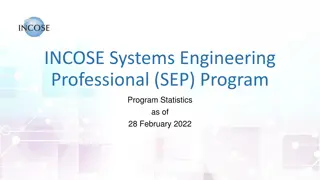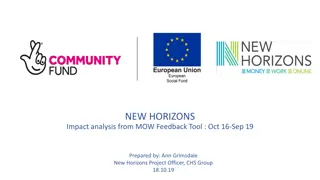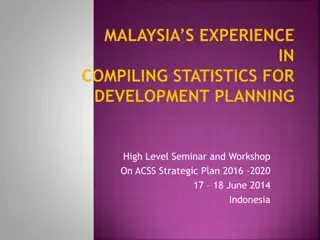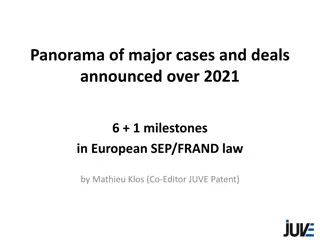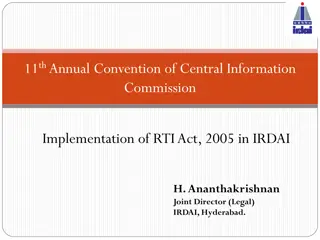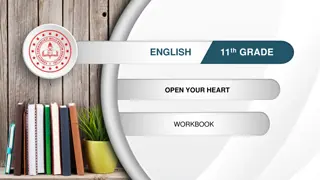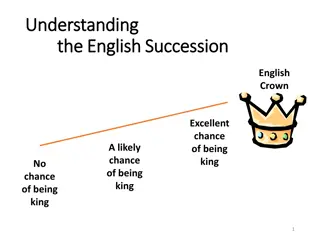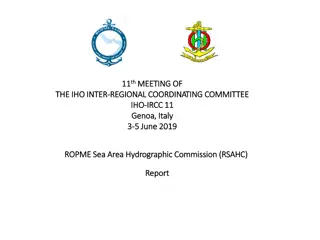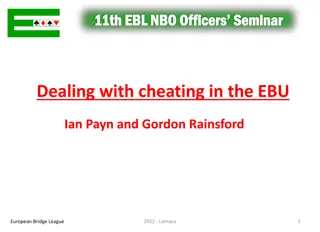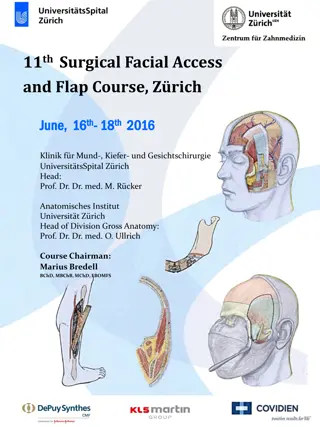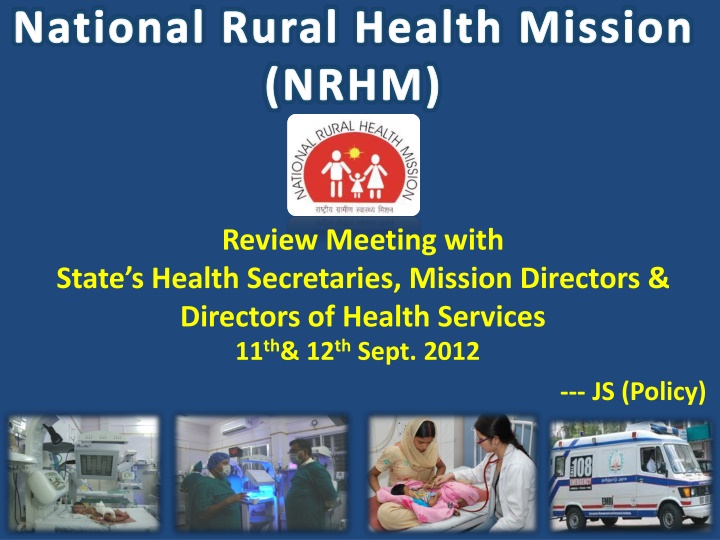
National Rural Health Mission Review Meeting Outcomes 2012
Explore the outcomes of the National Rural Health Mission review meeting in 2012, including improvements in Maternal Mortality Ratio, Infant Mortality Rate, Total Fertility Rate, Disease Control Programs, and enhancements in healthcare infrastructure and human resources.
Download Presentation

Please find below an Image/Link to download the presentation.
The content on the website is provided AS IS for your information and personal use only. It may not be sold, licensed, or shared on other websites without obtaining consent from the author. If you encounter any issues during the download, it is possible that the publisher has removed the file from their server.
You are allowed to download the files provided on this website for personal or commercial use, subject to the condition that they are used lawfully. All files are the property of their respective owners.
The content on the website is provided AS IS for your information and personal use only. It may not be sold, licensed, or shared on other websites without obtaining consent from the author.
E N D
Presentation Transcript
National Rural Health Mission (NRHM) Review Meeting with State s Health Secretaries, Mission Directors & Directors of Health Services 11th& 12th Sept. 2012 --- JS (Policy) 1
Status of Drop in MMR (in points) from 2004-06 to 2007-09 MMR (212 as per RGI report 2007-09) Assam 90 U P/Uttarakhand 81 Annual Rate of decline between 2004-06 and 2007-09 is 23% higher than annual rate of decline between 1999- 2001 and 2004-06 Rajasthan 70 M P/Chhattisgarh 66 Bihar/Jh. 51 Orissa 45 INDIA 42 Karnataka 35 Haryana 33 Maharashtra 26 EAG States showed a decline of 67 points in MMR (in compared to 2004-06) against a Decline of 42 points Punjab 20 Andra Pradesh 20 2007-09 T N 14 Kerala 14 National Gujarat 12 2 0 20 40 60 80
IMR reduced from 58 in 2005 to 47 as per SRS 2010 Rate of Decline of IMR accelerated by 29 % between 2005-10 as compared to 2000-2005 Decline in Rural IMR and U5MR is higher than the decline in urban areas, thereby narrowing the Rural - Urban Gap Decline of U5MR & IMR is more in EAG States India has remained free of Wild Polio for more than a year 3
TFR declined to 2.5 in 2010 as against 2.9 in 2005 Category State SRS-2005 SRS-2010 Point Change Bihar UP MP Rajasthan Jharkhand Chhattisgarh All India 4.3 4.2 3.6 3.7 3.5 3.4 2.9 3.7 3.5 3.2 3.1 3.0 2.8 2.5 -0.6 -0.7 -0.4 -0.6 -0.5 -0.6 0.4 Very High Focus states for FP Nationally Rate of Decline of TFR between 2005-2010 increased by 47 % as compared to 2000-2005 All the 6 very high focus states have shown a decline equal to or better than All India average Steepest decline in annual growth rate from 1.97 to 1.64 since independence 4
Disease Control Programmes Malaria Mortality Reduction Rate 55% mortality reduction in malaria in 2010 as against 2006 Dengue Mortality Reduction Rate 26% mortality reduction in dengue in 2010 as against 2006 More than 60 Lakh Cataract Operations every year Cataract operations Reduced from 1.8 per 10000 in 2005 to less than 1 per 10000 Leprosy Prevalence Rate 73% case detection rate and 88% Cure rate Tuberculosis 5
Over 1.5 lakh Human Resource added (on a baseline of 2.17 lakh) 2315 Referral Hospitals strengthened to act as First Referral Units (FRUs) with capacity to provide comprehensive obstetric emergency care 8475 PHCs upgraded as 24x7 PHCs 2012 Mobile Medical Units (MMUs) provided in 449 districts for delivery of health care in difficult areas 7218 Emergency Response / basic ambulance service vehicles Nation-wide system of HMIS and MCTS set up to ensure and monitor health interventions 6
SHORT FALL OF DOCTORS, SPECIALISTS AND NURSING STAFFS (IN PERCENTAGE OF TOTAL REQUIREMENT) SHORT FALLS OF DOCTORS IN PHCs AND SPECIALISTS IN CHCs SHORT FALL OF NURSING STAFFS IN PHC AND CHC 80% 73% 72% 80% 70% 64% 68%65% 64% 63% 62% 63%60% 70% 60% 58% 60% 50% 50% 40% 35% 40% 30% 30% 23% 20% 20% 10% 10% 0% 0% SOURCE: RHS 2011
SHORT FALL OF PARAMEDICS AND MPW (In % of total requirement) SHORT FALL OF PARAMEDICS IN CHCS SHORT FALL OF MPW (MALE) IN SUB CENTERS 100% 92% 90% 82% 120% 80% 100%100%92%89%86% 70% 100% 70% 57% 56% 60% 80% 50% 42% 65% 40% 60% 30% 20% 40% 10% 20% 0% 0% SOURCE: RHS 2011
INFRASTRUCTURE STRENGTHENING- I New Construction (Completion Rate < 30%) J&K, CHATTISHGARH ANDHRA PRADESH SUB CENTRE (SC) ANDHRA PRADESH, W.BENGAL, MAH., TN, DELHI JHARKHAND, ODISHA, UTTARAKHAND, ARUNACHAL PRADESH, MEGH. , NAGALAND, TRIPURA PRIMARY HEALTH CENTER (PHC) KERALA, W. BENGAL, HARYANA, KARNATAKA, MAHARASHTRA, UTTARAKHAND, UP NAGALAND, ASSAM, MIZORAM COMMUNITY HEALTH CENTER (CHC) KERALA ODISHA, UTTARAKHAND, J&K DISTRICT HOSPITAL (DH)
INFRASTRUCTURE STRENGTHENING- II Renovation And Up gradation (Completion Rate < 30%) CHHATTISGARH, J&K, UTTARAKHAND ARUNACHAL PRADESH, SIKKIM A&N ISLANDS SUB CENTER (SC) CHATTISHGARH, JAMMU & KASHMIR, SIKKIM ANDAMAN & NICOBER , CHANDIGARH, DELHI, PODUCHERRY PRIMARY HEALTH CENTER (PHC) BIHAR, J&K, MANIPUR, GOA, WEST BENGAL A&N ISLANDS, DELHI COMMUNITY HEALTH CENTER(CHC) UP, J&K, MANIPUR, NAGALAND, ANDHRA PRADESH, HARYANA, KERALA, WEST BENGAL A&N ISLANDS, CHANDIGARH, DELHI DISTRICT HOSPITAL (DH)
CONSTITUTION OF VILLAGE HEALTH SANITATION AND NUTRITION COMMITTEE (VHSNC) 98% 97% 97% 100% 93% PERCENT OF VHSNC CONSTITUTED OUT OF TOTAL VHSNC REQUIRED 90% 78% 80% 72% 70% 60% 54% 50% 49% 50% 40% 30% 16% 20% 10% 0% SOURCE: RHS 2011
STRENGTHENING HEALTH INSTITUTIONS- I (24X7 PHCs) 120% 96%100% 100% States with less than 50% of total PHCs as 24X7 PHCs 100% 77% 80% 60% 35% 40% 19% 10% 13% 14% 14% 20% 4% 0%
STRENGTHENING HEALTH INSTITUTIONS- II (FRUs) States with less then 50% of DH, SDH &CHC as FRUs 100% 91% 92% 90% 80% 69%71% 70% 55% 60% 50% 36% 40% 30% 11%13% 14%18% 18% 19% 20% 4% 10% 0%
Action Plan for the Year 2012-13
STATES WITH CUSHION MORE THAN Rs 10 Crores 474.41 In Crores 10000 9000 8000 7000 6000 5000 113.41185.74134.6453.52 31.58 4000 3000 35.7246.04 2000 92.34 1000 12.4 0 RESOURCE ENVELOPE AMOUNT APPROVED CUSHION AVAILABLE
CONDITIONALITIES: IMPLEMENTATION FRAMEWORK 1. Rational deployment of HR with the highest priority accorded to high focus districts and delivery points (Non compliance would lead to reduction of up to 7 %) % incentive/ Disincentive Otherwise, deduction of 2% of MFP Method of verification Policy notification ; Website posting Conditionalities and incentives Progress by the State 1.1 including- Posting of staff on the basis of case load, rational deployment of specialists, priority to HF districts Rational deployment policy In place by October, 2012 Minimum for all delivery points and SCs in high focus districts; by Nov 2012 90% of all delivery points staffed as per norms, 90% of all SCs in high focus districts should have at least one ANM Otherwise, deduction of 2% of MFP. Website posting and state report 1.2.1 Preparation of baseline data for HR Otherwise, deduction of 2% and 1.5% of MFP respectively. State report; website posting by December 2012. 1.2.2 Evidence of corrective action in line with the policy
CONDITIONALITIES: IMPLEMENTATION FRAMEWORK 2. Facility wise performance audit and corrective action based thereon. (Non compliance would lead to reduction of up to 7 % of MFP) % incentive/ Disincentive Method of verification Conditionalities and incentives Progress by the State 2.1.1 Range of services (as in MNH guidelines for RCH services, OPD, IPD and other services to be determined by the State) specified at least for delivery points State report and Website posting by September, 2012 Up to 2 % of MFP By September, 2012 State report ; State HMIS October data to be uploaded by November State reports on corrective action by Nov, 2012. State visits 2.2.1 Facility wise reporting on HMIS portal by all priority facilities/delivery points for October( SC data if needed be uploaded from PHC) Up to 2 % of MFP By November, 2012 2.2.2 Corrective action (priority to be given to high focus districts) based on facility wise reporting. By November, 2012 Up to 2 % of MFP
CONDITIONALITIES: IMPLEMENTATION FRAMEWORK 3. Gaps in implementation of JSSK (May lead to a reduction in outlay upto 10% of RCH base flexi-pool) Progress by the State % incentive/ Disincentive Method of verification Conditionalities and incentives Copy of GO ; Website posting 3.1.1 Government order for coverage of entire State regarding JSSK By Sept 2012 Upto 2 % of RCH base flexi-pool Sample community visits 3.2.1 State wide dissemination of GO/policy, visible IEC in facilities and community awareness By Oct 2012 Up to 2 % of RCH base flexi-pool Field visits; exit interviews grievance redressal records. 3.2.2 No user charges. Free Drugs, diagnostics, diet. Grievance redressal system operational By Oct 2012 Upto 2 % of RCH base flexi-pool 3.2.3 At least 50% of pregnant women and sick newborns coming in should be using assured and cashless means of transport- and getting a similar drop back home By Nov 2012, Upto 2 % of RCH base flexi-pool -do-
CONDITIONALITIES: IMPLEMENTATION FRAMEWORK 4. Continued support under NRHM for 2nd ANM would be contingent on improvement on ANC coverage and immunization as reflected in MCTS. Vaccines, logistics and other operational costs would also be calculable on the basis of MCTS data Conditionalities and incentives Progress by the State Method of verification Increase in April- December 2012 over the same period last year MCTS website ; state report by January, 2013 4.1 Increase in ANC coverage ( first ANC and full ANC) as per MCTS data in (1) State (2) High Focus districts Increase in April- December 2012 over the same period last year MCTS website ; state report by January, 2013 4.2 Increase in full immunization as per MCTS data in (1) State (2)High Focus districts
CONDITIONALITIES: IMPLEMENTATION FRAMEWORK 5. Responsiveness, transparency and accountability ( incentive upto 8% of MFP) Method of verification Progress by the State % incentive/ Disincentive Conditionalities and incentives 5.1 Demonstrated including innovations for responsiveness in particular to local health needs e.g use of epidemiological data, active participation of public representatives in DHS / RKS meetings , etc. 5.2 Demonstrated evidence/innovation transparency e.g. mandatory disclosures and other important information including HR posting etc. to be displayed in the State NRHM websites etc. Innovation implemented and impact demonstrated; State to send brief report in format suggested by November, 2012. ( one innovation in each of the three areas) State report (format in Annex 1) by November, 2012 ; state visits for rapid appraisal Up to 8% of MFP for 5.3 accountability: e.g. initiatives in community monitoring, Jan sunwai etc Demonstrated evidence/innovation for
CONDITIONALITIES: IMPLEMENTATION FRAMEWORK 6. Quality assurance (incentive upto 3% of MFP) % incentive/ Disincentive Method of verification Notification and state report by November, 2012 Conditionalities and incentives Progress by the State 6.1.1 policy/strategy policy) as well as standards States notify quality national In place by November 2012 (align to Up to 3% of MFP 6.2.1 Constitute dedicated teams. Training of state and district quality team and DH quality team completed State team trained by November 2012 Quality scores of all priority facilities available in public domain 6.2.2 measured for all priorityfacilities and scored and available on public domain. Deadlines for each facility to achieve quality standards declared Current levels of quality
CONDITIONALITIES: IMPLEMENTATION FRAMEWORK 7. Inter-sectoral convergence (incentive upto 3% of MFP) Progress by the State % incentive/ Disincentive Method of verification Conditionalities and incentives 7.1.1 Implementation frame work for intersectoral convergence sectors/departments State report (copy of implementation framework ) By Up to 1% of MFP with allied November 2012 7.2.1 Intersectoral convergence opportunities identified with WCD, PHED, education, etc. and action initiated. By Up to 2% of MFP Government order , State report November 2012
CONDITIONALITIES: IMPLEMENTATION FRAMEWORK 8. Recording of vital events including strengthening of civil registration of births and deaths (incentive upto 2% of MFP). % incentive/ Disincentive Method of verification Strategy document and policy statement. Conditionalities and incentives Progress by the State 8.1 A strategy paper identifying reasons and the road map for increasing registration By October 2012 Up to 1% of MFP Death reports received at district level- verified in sample of districts. 8.2 Death reports with cause of death (especially any under 5 child or any woman in 15 to 49 age group) shared with district health team on monthly basis. By November 2012 Up to 1% of MFP
CONDITIONALITIES: IMPLEMENTATION FRAMEWORK 9. Creation of a public health cadre (by states which do not have it already) (incentive upto 10% of MFP) % incentive/ Disincentive Method of verification State report website posting by November , 2012 Conditionalities and incentives Progress by the State 9.1.1 Stated policy and road map (including career path on creation of a public health cadre) Policy & road map in place by November , 2012 Up to 4% of MFP Website posting / state report 9.2.1 Notification for creation of public health cadre Government order in place. Up to 6% of MFP
CONDITIONALITIES: IMPLEMENTATION FRAMEWORK 10. Policy and systems to provide free generic medicines to all in public health facilities( incentive upto 5% of MFP ) Progress by the State % incentive/ Disincentive Method of verification Conditionalities and incentives 10.1.1 Clear policy articulation of free generic medicines to all in public health facilities 10.2.1 EDLs finalised and drug formulary published and made available in all public health facilities 10.2.2. Overall procurement and logistics strategy in place. Detailed design and plan for rate contracting, regular stock up dates, indent management, warehousing, promotion of rational contingency funds with devolution of financial powers etc. in place. By October 2012 Website posting / state report Notification/ Publication/ Web posting Upto 2% of MFP By November 2012 Up to 3% of MFP By State report/ strategy document November 2012 drug use,
Responsiveness, transparency and accountability Format for state report State to provide a brief write up (<3 pages) on the best practice on Responsiveness, transparency and accountability separately Suggested structure: Background: (Elaborate on the problem, which the innovation seeks to address; and in particular, provide details of target group/ base line data, if available) Description of the innovation: (Including date of commencement and current status; coverage in terms of districts/ blocks/ villages; overall approach / strategy; implementation/ institutional arrangements; whether pilot / scaled up) Costs: (Broad break up of one-time and recurring costs; assessment of cost effectiveness) Sustainability: (Assess organisational and financial sustainability and approach to ensuring the same) Outcome:(Extent to which base-line conditions have improved; results of third party evaluations, if carried out)




